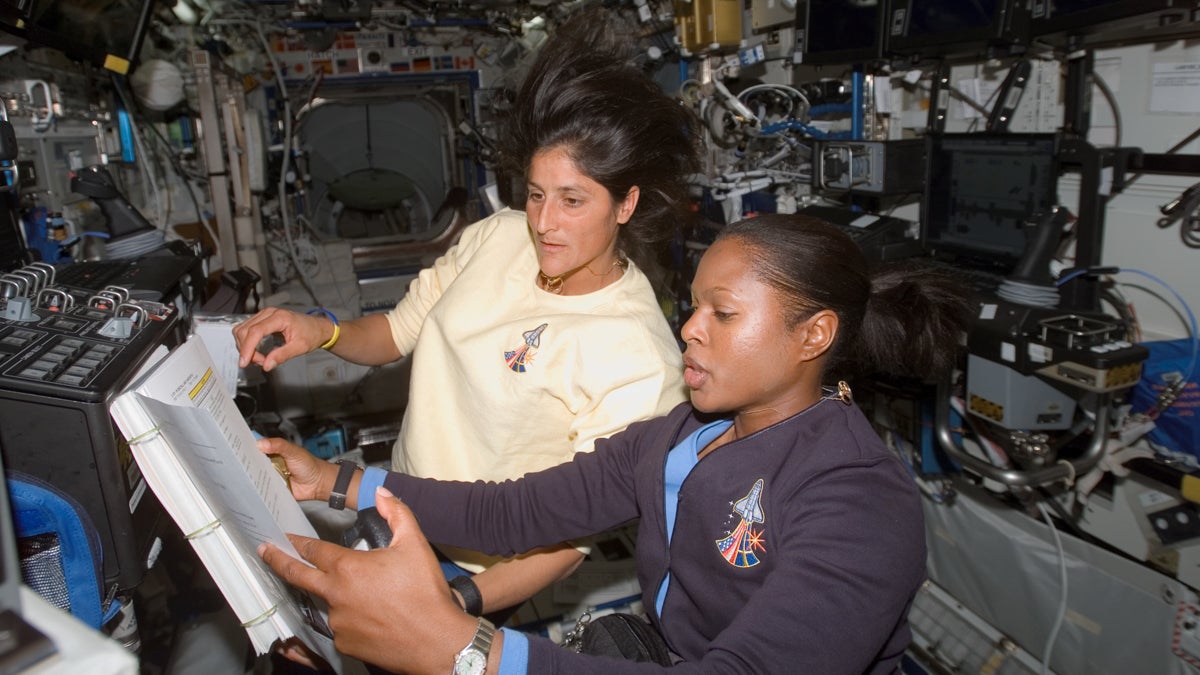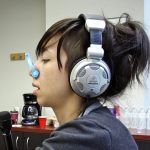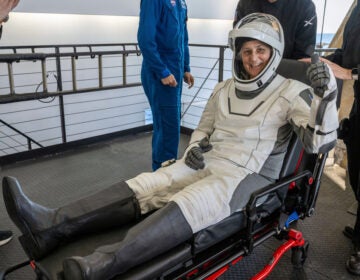How do astronauts deal with conflict in cramped quarters?
 Photo via NASA)" title="getting-along" width="1" height="1"/>
Photo via NASA)" title="getting-along" width="1" height="1"/>
Astronauts Joan E. Higginbotham and Sunita L. Williams refer to a procedures checklist as they work together in the Destiny laboratory of the International Space Station. (Photo via NASA)
Getting along with your coworkers can be tough in any job – much less one where you eat, sleep and work just feet away from one another.
So how do astronauts do it?
That’s what Nick Giovannucci wanted to know in response to The Pulse’s call for questions about space.
“Living in such close quarters, I can’t imagine that they always get along,” he wrote. “So how do astronauts resolve differences between them?”
According to NASA psychologist Al Holland, Nick’s instinct about the stresses of space are spot on.
“We’re putting normal people into a very abnormal environment, and we’re asking them to work and to live together,” he says.
So far, he says, NASA’s solution has been twofold: changing the people, and changing the environment.
NASA has been relatively successful at the latter. Over the years, technological advancements have allowed for increased space, improved comfort, and easier communication between astronauts and their families.
Finding the right astronaut for the job
Changing a person’s behavior can be a little trickier, but Holland says it begins with who they choose to send on missions in the first place.
“We do a pretty comprehensive job of selecting individuals that will fit the missions that we have on our plate,” Holland says.
The first step of that process involves making sure that astronauts meet an established baseline level of mental health.
“The selection of astronauts tends to favor people who don’t have major characterological issues or neurotic issues – they’re screened out,” says space psychologist Nick Kanas. “You don’t become an astronaut if you have neurotic conditions that are in your past, or any kind of genetically predisposed illnesses such as bipolar [disorder] or schizophrenia or a history of alcoholism.”
Holland says NASA also looks for specific personality traits that will allow astronauts to do well on long-term space missions, such as flexibility, ability to adapt, tolerance and good social skills.
These traits are especially important for astronauts because they’re working under extreme conditions, both physically and psychologically.
“It’s what we call an ICE environment – that’s an isolated and confined environment,” Holland says. “Those environments can be quite stressful.”
Buildups of stress, in turn, can affect both performance and interpersonal interactions – no matter how stable you are. That’s why astronauts undergo lengthy trainings alongside their fellow crew members before they’re allowed in space.
“When a person first enters the organization as an astronaut, the astronaut has two years of training,” Holland says. “[Training includes] dedicated time where they begin learning about the systems that they’ll be working with in space, as well as learning how to work with one another and how to manage themselves in a confined environment.”
NASA does this in part through expeditionary missions that are meant to simulate the isolation, stress and dangers of a space mission. Astronauts have been sent everywhere from remote cabins in the Canadian tundra to NASA’s underwater research station, Aquarius, where they practice conducting research under challenging physical and mental conditions.
“They will work and have a schedule just like on the space station in an operational environment,” Holland says. “They’ll learn to work as a team and they’ll debrief each evening, and assess what they could do better on the next day.”
This helps teams bond and hone essential skills related to communication, leadership, self care and mastery over their emotions and behavior. It also helps NASA ensure that teams feature a healthy balance of skills and personalities.
Dealing with group dynamics
That balance can cover more than just temperament. Kanas says that diversity among crew members – in terms of gender, race, nationality and even specialization – can also affect the group dynamic.
“Homogeneous groups tend to bond early very well, and keep bonding pretty well. But then sometimes they get a little bored of each other,” he says.
Heterogeneous groups, by contrast, often have to put in more work at the outset to gel as a team, but can provide one another with much-needed stimulation down the road, when cabin fever begins to take hold.
Of course, some differences are easier to navigate than others. On the International Space Station, for example, crew members may hail from any of more than a half–dozen countries, which can open the door to conflict based on culture clash.
“I think everyone who’s worked in an international group, or has worked with someone from another culture, understands all the communication that can be misconstrued,” Holland says.
That’s why NASA includes cross-cultural training as part of its preparation; and while Kanas notes that astronauts from different countries must often navigate divergent working styles, as well as other barriers to communication, his studies have shown that the two most-represented nationalities – Americans and Russians – get along well.
“We just try to push forward information about different cultures, and we want information about our culture shared with them,” says Holland. “So we’re trying for a mutual approach there with one another.”
Once astronauts are in space, however, they’re on their own. Selecting the right mix of personalities, forging a team bond, and training on how to deal with stress, all help crews deal with interpersonal conflict themselves.
When none of these work, Kanas says astronauts sometimes resort to less desirable behaviors.
“Withdrawal and working more independently is a coping strategy where you don’t have to deal with the other guy or other girl,” Kanas says, adding that this can sometimes lead to more aggressive behavior, such as being overly territorial.
In his research, Kanas has also observed astronauts displacing their frustration with one another onto mission control – a subconscious strategy, he says, that allows them to blow off steam without hurting their relationships with fellow crew members.
“In a sense, it’s a reaction to the interpersonal stress, but it’s also a coping strategy that helps you relieve the anxiety for a period of time by displacing the anxiety and tension and anger outwardly, so you don’t have to deal with it with your crewmembers,” he says.
Many of these coping mechanisms – both formal and informal – have unfolded over the years, as NASA’s missions have grown longer. But both Holland and Kanas say new strategies will need to be developed as NASA looks toward its longest mission yet – a manned voyage to Mars.
Kanas has suggested regular “bull” sessions that would give teams regular opportunities to check in with one another and air any complaints. Holland, meanwhile, says NASA is working on new strategies to help teams debrief one another and process negative information.
At the end of the day, however, Holland says astronauts are just normal people, which means conflict will sometimes happen.
“Expecting the astronauts to be perfect individuals – and never have any tensions, and never have any conflict, never have any negative feelings – is completely unrealistic, and it’s not what we would want to encourage,” he says.
“We aren’t looking for perfect people. And in fact, if you’ve ever worked with someone who thinks they are perfect, you know it’s not a pleasant experience.”
WHYY is your source for fact-based, in-depth journalism and information. As a nonprofit organization, we rely on financial support from readers like you. Please give today.







